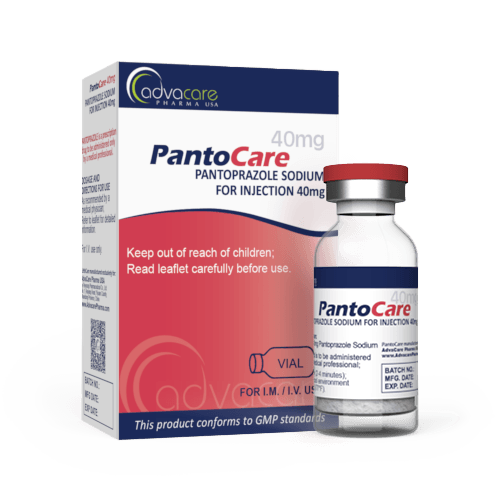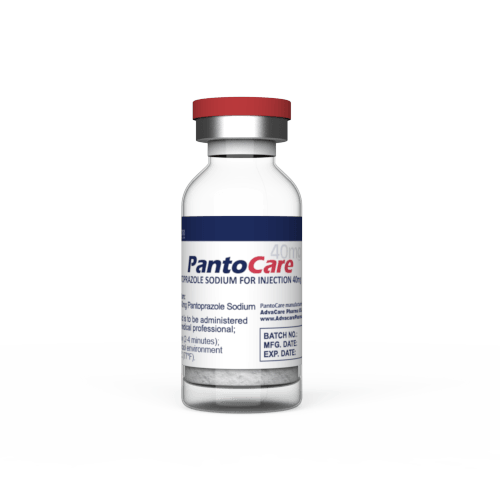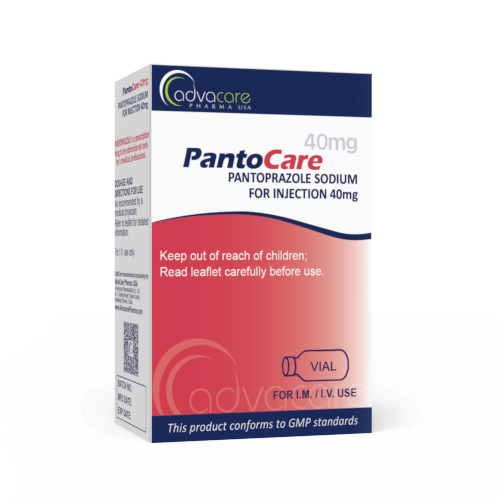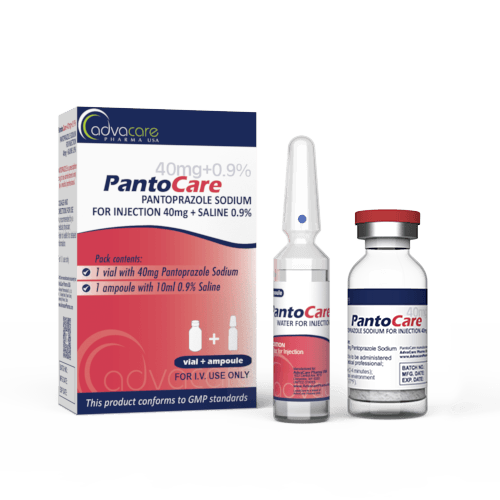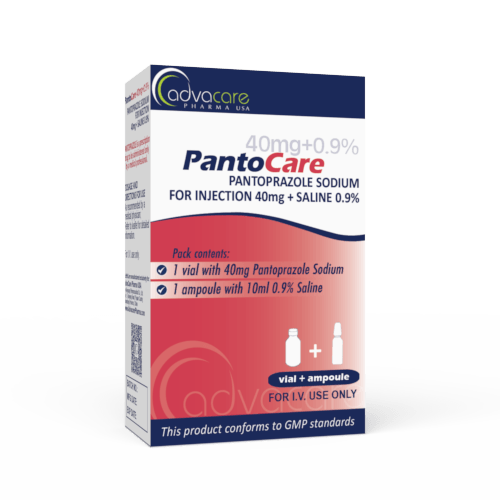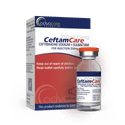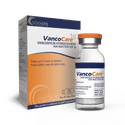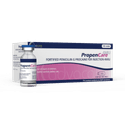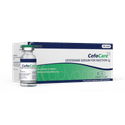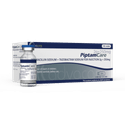- Home›
- Pharmaceuticals›
- Injections›
- Powder for Injection›
- Pantoprazole for Injection
Pantoprazole for Injection
Dosage
Packaging
What is Pantoprazole Sodium?
Active Ingredients: Pantoprazole Sodium
Pantoprazole Sodium for Injection is used to treat conditions caused by excess stomach acid production. It relieves symptoms that may be associated with gastroesophageal reflux disease or erosive esophagitis. Intravenous treatment is typically prescribed for patients unable to take oral medications.
Intravenous pantoprazole sodium is indicated for reflux esophagitis, gastric or duodenal ulcers, Zollinger-Ellison-Syndrome, and other pathological hypersecretory conditions.
Pantoprazole is classified as a proton pump inhibitor (PPI). It is a substituted benzimidazole that works by blocking the activity of parietal cell hydrogen-potassium ATPase (proton pumps) in the stomach. This action stops the production of gastric acid (hydrochloric acid, HCl) and therefore reduces the amount of acid secreted into the stomach.
Pantoprazole Sodium for Injection is available in 2 packaging options: a vial of 40mg dosage of the active ingredient packaged in a box or a combination product containing a vial of 40mg pantoprazole and an ampoule with 0.9% saline solution (sodium chloride). The saline can be used as a solvent to dilute the medicine, making the combination product convenient for intravenous administration.
Intravenous pantoprazole sodium is typically administered in hospitals. After IV therapy, some patients with long-term conditions are advised to continue PPI treatment using Pantoprazole Tablets.
Pantoprazole Sodium for Injection has been manufactured in a GMP-certified facility by AdvaCare Pharma. This medication is a part of our extensive catalog of medical supplies available for global distribution. Our manufacturing facilities are located in China, India, and the USA.
Why choose us as your Pantoprazole manufacturer?
AdvaCare Pharma, a US-owned pharmaceutical company, is a manufacturer of Pantoprazole for Injection with GMP-compliant manufacturing facilities located worldwide. We conduct frequent GMP, third-party and internal facility inspections to ensure that our manufactured injectable treatments exceed the stringent requirements of importing countries and our distributors.
As a renown Pantoprazole manufacturer and global supplier of 120+ pharmaceutical injection products, our global reach extends to over 65 markets ensuring that pharmaceutical distributors, hospitals, pharmacies, NGOs and government institutions receive the quality-assured treatments they need.
Uses
What is Pantoprazole for Injection used for?
It is used to relieve symptoms caused by excess stomach acid production. It is used in the treatment of:
- symptomatic gastroesophageal reflux disease (GERD) with or without erosive esophagitis
- hypersecretory conditions, including Zollinger-Ellison Syndrome
- upper gastrointestinal bleeding
What is the difference between Pantoprazole and Omeprazole?
Pantoprazole and Omeprazole are both classified as proton pump inhibitors (PPIs) and are considered highly effective medicines for suppressing gastric acid. However, these PPIs have different chemical structures that require different dosages and have different durations of action. The difference in molecular structure may affect individuals in dissimilar ways, such as causing different side effects. Omeprazole is reported to have more known drug interactions than pantoprazole, making pantoprazole a better option for patients undergoing therapy with multiple medications.
It is important to note that different regions may have different indications or uses for intravenous forms of each of these drugs.
How is Pantoprazole for Injection used?
Pantoprazole sodium has been manufactured as a freeze-dried powder that is intended for reconstitution. It is intended to be mixed with saline (sodium chloride) and administered intravenously. Reconstituted solutions should be used within 24 hours, and the intravenous infusion should be administered over 2-15 minutes.
This product is not compatible with midazolam HCl when delivered through a Y-site. It may not be compatible with products containing zinc.
What are the storage recommendations for Pantoprazole Sodium for Injection?
Before use, this medicine should be stored at room temperature in a location free of moisture, heat, and light. Do not freeze the reconstituted or diluted solutions.
What happens if a dose is missed?
As intravenous pantoprazole sodium is typically administered to hospitalized patients who cannot tolerate oral medication, it is unlikely for a dose to be missed. In the event of a missed dose, the medicine should be administered as soon as possible, unless it it is time for the next dose. Two doses should not be administered at the same time.
What dose should be given?
Adult Dosing Recommended dosage guidelines may vary depending on medical condition:
- For non-erosive symptoms of GERD when oral treatment is unavailable or inappropriate, the usual dose is 20mg of pantoprazole, given once per day by IV. The duration of treatment is 7-10 days.
- For erosive esophagitis associated with GERD when oral treatment is unavailable (short-term treatment), the usual dose is 40mg of pantoprazole, given once per day by IV. The duration of treatment is 7-10 days.
- For erosive esophagitis associated with GERD when oral treatment is unavailable (maintenance treatment), the usual dose is 20-40mg of pantoprazole, given once per day by IV. The duration of treatment is 7-10 days.
- For hypersecretory conditions, the usual dose is 80mg of pantoprazole, given every 12 hours by IV. The dosage may increase to 80mg every 8 hours if needed. Doses of up to 240mg/day have been used in certain circumstances.
- For the treatment of upper GI bleeding, the usual dose is 80mg, given once.
The exact dosage is based on the severity of the infections, age, gender, and weight. Refer to a doctor or pharmacist for guidelines on dosage.
Pediatric Dosing Dosing guidelines have not been established for pediatric patients.
Who can use Pantoprazole Sodium?
Pantoprazole for Injection can be given to adults, but caution is advised for specific groups of patients.
Pregnant Pantoprazole should be avoided in pregnant women, and should only be administered if the benefits outweigh the risks. There have been conflicting human data on the risk of teratogenicity. Animal studies have indicated reproductive toxicity at twice the human clinical exposure amount.
Breastfeeding Pantoprazole can be used while breastfeeding, though there is insufficient human data available to fully assess the risk of infant harm. Some animal studies have indicated excretion into milk.
Children Pantoprazole has not been proven safe for children under the age of 5 years old. For pediatric patients unable to tolerate oral therapy, there is limited and variable data available in regard to weight-directed dosing and BSA-directed dosing.
Geriatric There is no dose adjustment necessary for elderly patients.
Other warnings
For patients with severe hepatic impairment, a dose of 20mg per day should not be exceeded. Liver enzymes should be regularly monitored during treatment. Therapy should be discontinued if there are elevated liver enzymes.
No dose adjustment is necessary for patients with renal impairment, including those on dialysis.
Treatment with pantoprazole is associated with a slightly increased risk of gastrointestinal infections due to certain types of bacteria, such as Salmonella, Campylobacter, or C. difficile.
Pantoprazole may mask the symptoms of gastric malignancy, which may delay a proper diagnosis. If symptoms, such as significant weight loss, vomiting, or anemia, are present along with a suspected gastric ulcer, additional follow-up and diagnostic testing may be necessary to rule out stomach cancer.
Prolonged treatment with PPIs may cause hypomagnesemia. Patients undergoing long-term treatment or those who also take other medicines that increase the chance of hypomagnesemia (e.g. diuretics) may need to have their magnesium levels monitored.
Patients with osteoporosis or other bone density risk factors are advised to ensure an adequate intake of vitamin D and calcium during treatment.
Side Effects
As with all pharmaceuticals, some unwanted effects can occur from the use of Pantoprazole for Injection.
Common side effects include, but may not be limited to:
- pain or redness at the injection site
- headache
- joint pain (arthralgia)
- vomiting or diarrhea
- benign fundic gland polyps
- cold-like symptoms, fever, or rash (common in children)
Seek medical attention if the following develop:
- bruising or swelling at the injection site (thrombophlebitis)
- signs of an allergic reaction
- blood in the stool
- seizures
- signs of a kidney problem (e.g. changes in urination, fever, nausea, weight gain)
- signs of low magnesium (e.g. dizziness, irregular heart rate, persistent muscle spasms)
- new or worsening symptoms of lupus
Some rare but serious reactions may include:
- Stevens-Johnson syndrome
- necrolysis
- rhabdomyolysis
- blood dyscrasias
- pancreatitis
Consult a doctor or pharmacist for a comprehensive list of all side effects.
If any symptoms persist or worsen, or you notice any other symptoms, please call your doctor.
Precautions
Do NOT use Pantoprazole for Injection if:
- You are allergic to any of the ingredients or any similar drugs, such as dexlansoprazole, esomeprazole, lansoprazole, omeprazole, or rabeprazole.
- You have been using other proton pump inhibitors or benzimidazole.
- You have severe hypomagnesemia.
- You are being treated with rilpivirine or nelfinavir.
This medication may not be suitable for people with certain conditions, including:
- low level of zinc, magnesium, or calcium (such as hypomagnesemia and hypocalcemia risk)
- systemic lupus erythematosus
- osteoporosis or low bone mineral density
As pantoprazole decreases stomach acid, it may change how well certain medications work. Other medications may affect the efficacy of pantoprazole or increase the likelihood of adverse effects. Consult with a doctor about any medications you are taking before your treatment. Some known interactions include but are not limited to certain azole antifungals (e.g. ketoconazole, itraconazole, posaconazole), coumarin anticoagulants (e.g. phenprocoumon, warfarin), HIV protease inhibitors, iron supplements, diuretics, digoxin, or methotrexate. Treatment with pantoprazole is contraindicated with rilpivirine.
High-dose therapy or long-term usage of this drug should be avoided unless necessary. Long-term therapy is associated with risks such as B-12 deficiency, increased risk of polyps, and bone fractures.
Pantoprazole does influence an individual's ability to drive or use machinery. Some patients may experience dizziness and/or visual disturbances as a side effect and should not drive or operate machinery.
This drug may interfere with certain laboratory tests. Treatment should be stopped for at least 5 days prior to any Chromogranin A (CgA) testing. Pantoprazole may also cause false positives for tetrahydrocannabinol (THC) on drug-screening urine tests.
References
Pantoprazole for the Treatment of Peptic Ulcer Bleeding and Prevention of Rebleeding
The use of proton pump inhibitors (PPIs) alongside endoscopic therapy has become the standard treatment for peptic ulcer bleeding, with current guidelines advocating for high-dose intravenous (IV) PPI therapy (an initial IV bolus followed by continuous infusion).
This study focuses on the comparative effectiveness of high-dose versus low-dose PPI therapy. Maintaining a pH of ≥ 4 is thought to prevent mucosal bleeding in patients with acute stress ulcers, which has led to the increased recommendation of acid-suppressing therapy for stress ulcer prophylaxis in intensive care units (ICUs).
This study evaluates the evidence for the effectiveness of IV pantoprazole, a PPI, in preventing ulcer rebleeding after endoscopic hemostasis, as well as its role in controlling gastric pH and protecting against upper gastrointestinal (GI) bleeding in high-risk ICU patients.
The conclusion of this study is that IV pantoprazole is an effective option for treating upper GI bleeding, preventing rebleeding, and providing prophylaxis for acute stress ulcer bleeding.

You might be interested in...
Why AdvaCare Pharma?
As an industry leader, we are aware of our responsibility to provide affordable and sustainable solutions to improve healthcare worldwide.
